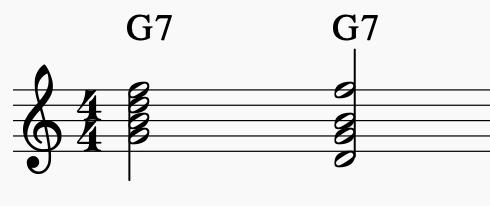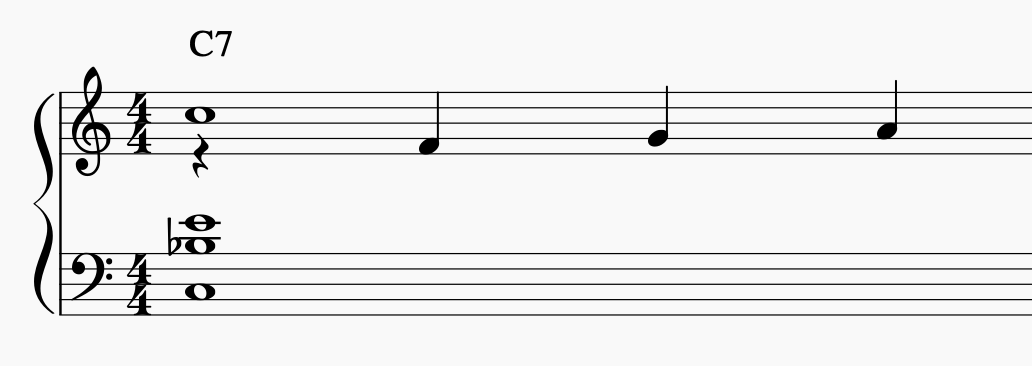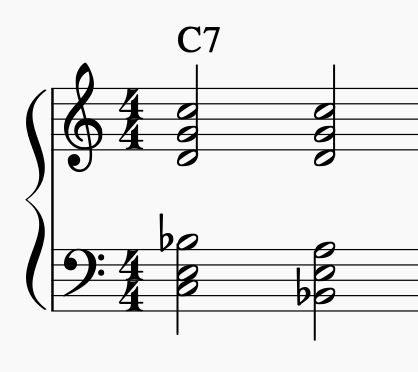The Pippinpotato Corner All things pippin and potato
Finding Two-Handed Jazz Voicings Based on the Melody Note
7 minute read

When we start learning jazz chords we are taught how to play block chords. Block chords are great, but I wanted a way to find better voicings on the fly according to the top melody note. It’s overwhelming trying to figure out a good two-handed voicing, as there are so many possible ways to voice a single chord. This is a system I use for creating good voicings based around what the melody top note is. Having a system makes it less daunting and gives you an organized approach to finding a voicing for a particular chord.
Drop-2
Drop 2 voicings are basically block voicings with the second highest note dropped an octave down.

On the left we see a regular block chord, and on the right we drop the D an octave down to create a Drop 2 voicing. The block chords I derive my Drop 2 voicings from are pretty vanilla, so I end up using Drop 2 voicings when I want to use a chord without too much tension. You can add the root to these as well.
(Root), Shell, and Pretty
This is pretty self-explanatory. In the left hand I optionally have the root, and I have the 3rd and the 7th. Then, the right hand will fill in the extensions, which are the 9th, 11th, 5th, or 13th. You can make the appropriate alterations to each pretty note.
It’s important to break down the approach to creating the chord, as taking it all at once can be overwhelming when trying to create these chords for the first time. I first look at the left hand and decide to play the 3rd and then 7th or 7th and then 3rd. Then I look at the melody note and look at which of the pretty notes between the top of the shell voicing and the melody note are available to me.


Above are two examples of voicing a C7 with Root, Shell, Pretty with two different choices of shell voicings. The root, shell, and melody note are represented with whole notes and the available pretty notes are represented with quarter notes. My left hand is too small to comfortably reach a tenth, so in the second example I would play the 3rd with my right hand.
Quartal
Quartal chords are great for creating space in your harmony, and I always opt for them when I want spacey sounding chords instead of chunky ones. The Jazz Piano Book has a lot of great, full sounding two-handed quartal voicings. One way to find quartal voicings for each melody note is to memorize these two-handed quartal voicings. However, there is a more organic way of constructing them on the fly by yourself. You don’t need both hands to play purely quartal intervals to get the spacey “quartal” sound in your voicing; it’s enough to only have quartal intervals in one hand. My system for finding quartal sounding voicings begins in the right hand, where I create a three note quartal voicing based on the top note. Then, in my left hand I typically fill in the root, shell, fifth, or continue the quartal intervals downwards. This is much easier than memorizing a giant five or six note quartal voicing.

Here are two examples of C7 quartal voicings with the root in the melody. In the first voicing I put the root and shell in the left hand. In the second voicing, I see that continuing on downwards in quartal steps includes the root and shell, so I do that.
Upper Structures
Upper structures voicing is when you play a triad over an existing chord. This simplifies the thinking process, as coming up with triads is generally faster than coming up with individual notes. I use these mainly over dominant 7ths, as they are a quick way for me to play the chord based on the alterations I want.

These are the five upper structure voicings I most commonly use. The name and quality of the 7th chord is listed on the bottom, and the name and quality of the triad is listed on top. These can be transposed into any key based on the scale degree and quality of the triad. For example, if you wanted to make a F7♯9♭13 chord, if you take a look at the C7♯9♭13 chord, you’ll see that the corresponding triad is an A♭ major triad. This is a major triad on the ♭6th scale degree of C. The ♭6th scale degree of F is D♭, so to make an F7♯9♭13 chord you would play a D♭ major triad over an F7 shell. In fact, it’s best to think of upper structure triads in terms of scale degree and triad quality so that you can easily transpose it into any key. I put it in terms of triad names above for simplification purposes.
To figure out which upper structure chord to play over a particular melody note, you have to kind of reverse engineer it. For each scale degree, there are only certain upper structure voicings that would work for it. For example, if you are playing a C7 with a C on top, the upper structures voicing with an A♭ major triad is the only voicing that has a C in it, so you can only use that one. On the other hand, if E is on top, both A major and D♭ minor are acceptable triads to use. I would suggest practicing by going up each scale degree and seeing which upper structure triad works for each scale degree. If you have time, this is helpful to go over in each key.
How To Practice
I’m still figuring out the best way to practice these voicings. The first practice method I tried was, for each type of two-handed voicing, going through all scale degrees of all keys and constructing a voicing based on that scale degree. However, this was time consuming, and I felt it was not effective for me. Now I practice this by going through whichever jazz standard I’m working on several times and finding an appropriate two-handed voicing for each note of the standard based on the note and the chord. Each time I go through the standard I’m only allowed to use one kind of chord voicing. For example, I might run through Stella By Starlight a couple of times, the first time using Root, Shell, Pretty with 3 then 7 in the shell, the second time using Root, Shell, Pretty with 7 then 3 in the shell, the third time using Drop-2 chords, and so forth. This way you can really be familiar with each type of voicing as its own isolated concept.
Final Note
This is a helpful system for finding two-handed jazz voicings, but by no means is this an end-all be-all for creating two-handed jazz voicings. This is just meant to serve as a framework to help guide your brain go about figuring out two-handed jazz voicings—a way to think about how to construct new two-handed jazz voicings. For example, for a Root, Shell, and Pretty voicing, maybe you want to add an 11th inside your shell. That is completely valid. Your ears should have the final say in whether it is a good sounding voicing or not.
Written on May 25th, 2020 by Chris Cheung